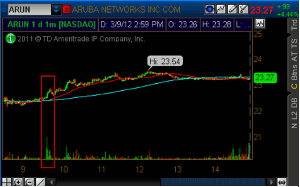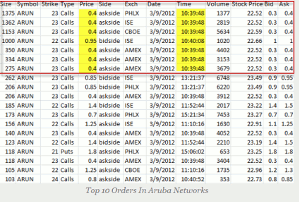Unusual option activity often signals a potential large move is because they indicate where the “smart money” is going, and that is who I want to follow, says Joshua Belanger of OptionSizzle.com.
As you know, good options traders use leverage to make profits with minimal capital. Being a buyer of an option is a low-probability trade since 60% of options expire worthless. To succeed in making a large profit in calls or puts, I believe you need to know where big money is going in the options market. Being able to spot where money is flowing in the options market will typically give you an edge to keep you ahead of the crowd. I have often noted that unusual option activity signals a potential large move.
The reason why unusual option activity often signals a potential large move is because “insiders” will typically act on information they hear or have a heads up on news that will cause the price of the stock to move. These insiders will scramble into the options market to make very large bets to profit on the leverage that options provide.
The activity in Aruba Networks Inc. (ARUN) below is a perfect example. On Fridays, I have a live chat room open for members so that we can trade weekly options together. At 10:58 am EST, I was running through my typical morning scans to track unusual options activity and I picked up on some big buyers of the March $23 calls at $0.40 per contract.
Below you will find a list of the top ten orders on that day, and you can see they came in at 10:39 am EST as buyers of large blocks of these contracts.
This type of action always gets my attention because these are buyers of call option contracts that expire in seven days, two of which are non-trading days. The only way these call options will profit is if prices move higher by the following Friday.
If you look at the one-minute chart below, you will notice a large spike in volume at the exact same time that those call options were bought.

1 Minute Chart Of Aruba Networks
Click to Enlarge
Right after that activity hit, the price of the stock continued to move another $1.00 higher. Those call options that were bought reached a high of $0.85 per contract and finished the day at $0.70 per contract.
Unusual option activity is only an indicator. In my opinion, it is the most real-time indicator available because it shows me where the money is going in the options market. I typically pick up on the unusual option activity and apply technical analysis to filter out ideas and find the trades that have the best risk to reward.
Unusual Options Activity – Here are My Four Tips:
1. Volume – Compare the call/put volume versus average daily trading volume. Take it a step further and compare the volume in a particular contract with prior open interest. I like to see the volume at least three times the average daily volume. If the volume is greater than the open interest, then you know that there is some unusual option activity. If you’re wondering if the volume is new, then look the next day to see the change in open interest.
I like to see option volume occur in large blocks of 100 contracts or more. This size indicates that the volume is a result of institutional buying rather than retail customers trying to find the next hot stock. The institutions tend to be the smart money and that is who I want to follow.
2. Go Backwards – When you notice a change in activity, look at the options in the front two months to see if anything catches your eye.
3. News – Unusual option activity does not happen in a vacuum. There is a reason for it and it is often connected with the headline news of the day. You’ll want to keep current of the news in the industry as well as press releases about conferences and other significant events.
After you have identified what looks to be some unusual option activity, you’ll have to determine if the activity is opening buys or sells. To do this, look at the bid and the ask on the contracts and watch to see where the last trade price is, to see if traders are aggressive in selling the option (hitting the bid) or buying the option (willing to pay the offer).
4. Spillover – Look for spillover into other strike prices. Market makers will typically take the other side of the trade. In other words, they want to remain delta neutral by selling calls to facilitate the transaction, and then, they will immediately offset their position utilizing the underlying stock. That means that they are buying stock against the calls they sold. However, if they think the buying is a result of smart money, they may hedge their position using other options which results in a spillover into the purchase of calls at different strikes.
I hope that you learned something from this information and that you can benefit from the tips that I shared today. I challenge you to start looking more into the options chain when looking at different ticker symbols.
By Joshua Belanger, Founder, OptionSizzle.com






















